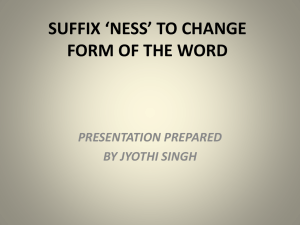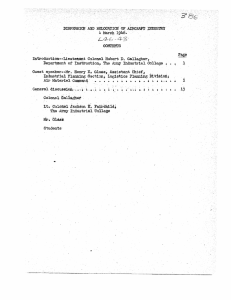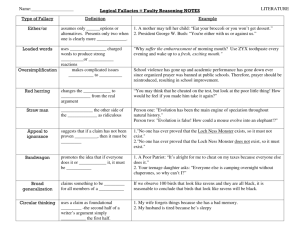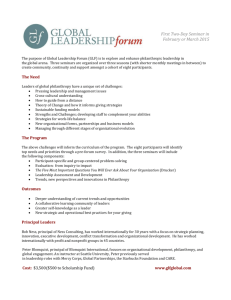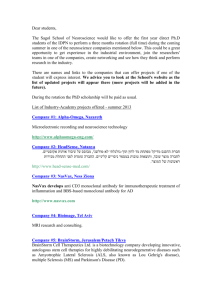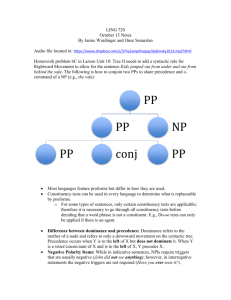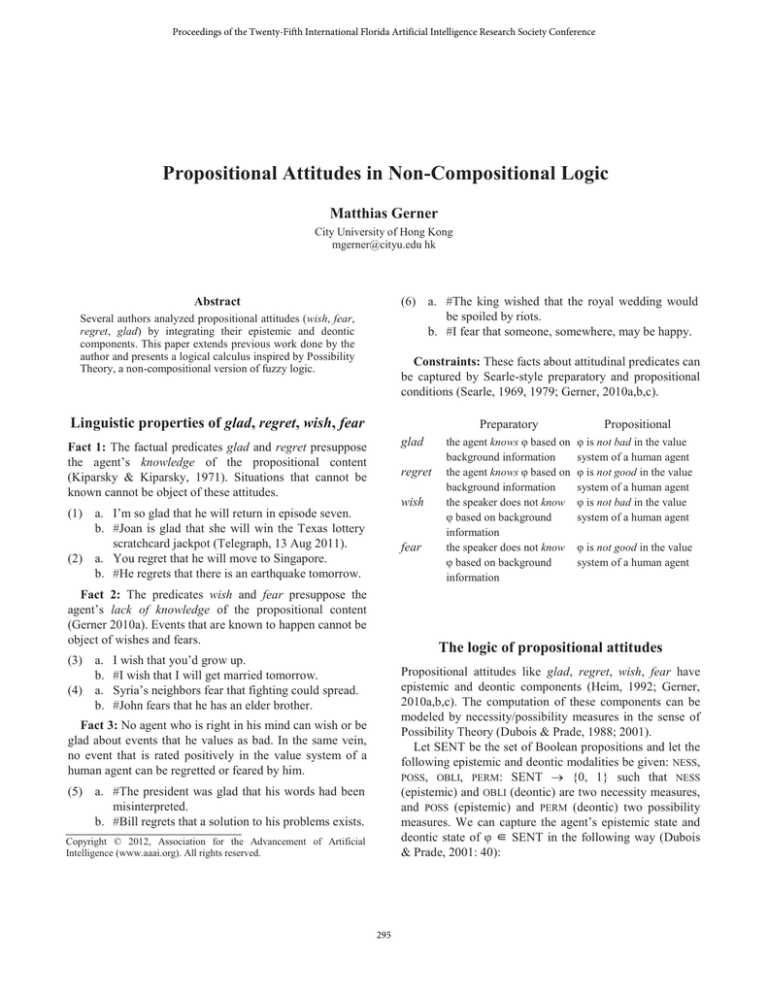
Proceedings of the Twenty-Fifth International Florida Artificial Intelligence Research Society Conference
Propositional Attitudes in Non-Compositional Logic
Matthias Gerner
City University of Hong Kong
mgerner@cityu.edu hk
Abstract
(6) a. #The king wished that the royal wedding would
be spoiled by riots.
b. #I fear that someone, somewhere, may be happy.
Several authors analyzed propositional attitudes (wish, fear,
regret, glad) by integrating their epistemic and deontic
components. This paper extends previous work done by the
author and presents a logical calculus inspired by Possibility
Theory, a non-compositional version of fuzzy logic.
Constraints: These facts about attitudinal predicates can
be captured by Searle-style preparatory and propositional
conditions (Searle, 1969, 1979; Gerner, 2010a,b,c).
Linguistic properties of glad, regret, wish, fear
glad
Fact 1: The factual predicates glad and regret presuppose
the agent’s knowledge of the propositional content
(Kiparsky & Kiparsky, 1971). Situations that cannot be
known cannot be object of these attitudes.
regret
wish
(1) a. I’m so glad that he will return in episode seven.
b. #Joan is glad that she will win the Texas lottery
scratchcard jackpot (Telegraph, 13 Aug 2011).
(2) a. You regret that he will move to Singapore.
b. #He regrets that there is an earthquake tomorrow.
fear
Fact 2: The predicates wish and fear presuppose the
agent’s lack of knowledge of the propositional content
(Gerner 2010a). Events that are known to happen cannot be
object of wishes and fears.
(3) a.
b.
(4) a.
b.
Preparatory
Propositional
the agent knows φ based on
background information
the agent knows φ based on
background information
the speaker does not know
φ based on background
information
the speaker does not know
φ based on background
information
φ is not bad in the value
system of a human agent
φ is not good in the value
system of a human agent
φ is not bad in the value
system of a human agent
φ is not good in the value
system of a human agent
The logic of propositional attitudes
I wish that you’d grow up.
#I wish that I will get married tomorrow.
Syria’s neighbors fear that fighting could spread.
#John fears that he has an elder brother.
Propositional attitudes like glad, regret, wish, fear have
epistemic and deontic components (Heim, 1992; Gerner,
2010a,b,c). The computation of these components can be
modeled by necessity/possibility measures in the sense of
Possibility Theory (Dubois & Prade, 1988; 2001).
Let SENT be the set of Boolean propositions and let the
following epistemic and deontic modalities be given: NESS,
POSS, OBLI, PERM: SENT {0, 1} such that NESS
(epistemic) and OBLI (deontic) are two necessity measures,
and POSS (epistemic) and PERM (deontic) two possibility
measures. We can capture the agent’s epistemic state and
deontic state of φ ∈ SENT in the following way (Dubois
& Prade, 2001: 40):
Fact 3: No agent who is right in his mind can wish or be
glad about events that he values as bad. In the same vein,
no event that is rated positively in the value system of a
human agent can be regretted or feared by him.
(5) a. #The president was glad that his words had been
misinterpreted.
b. #Bill regrets that a solution to his problems exists.
Copyright © 2012, Association for the Advancement of Artificial
Intelligence (www.aaai.org). All rights reserved.
295
a.
b.
c.
d.
The agent’s epistemic state of φ
(NESS(φ), NESS(φ)) =
(1,0) iff the agent knows φ;
(0,1) iff the agent knows φ;
(0,0) iff the agent neither knows φ nor φ;
(1,1) iff the agent knows both φ and φ
a.
b.
c.
d.
The agent’s deontic state of φ
(OBLI(φ), OBLI(φ)) =
(1,0) iff φ is good/binding;
(0,1) iff φ is bad/forbidden;
(0,0) iff φ is neither good nor bad (permissible);
(1,1) iff φ is both good and bad.
(7)
in multi-valued logics as continuous t-norm (Hajék 1998:
28; Gottwald 2008). We can define the following 16
logical attitudes of which at least four are lexicalized in
human languages: WISH, FEAR, GLAD, REGR..
(10)
Definition of 16 propositional attitudes
Predicate
(8)
PERM(φ)
PERM(φ)
WISH(φ) = POSS(φ) PERM(φ)
FEAR(φ) = POSS(φ) PERM(φ)
POSS(φ) OBLI(φ)
POSS(φ) OBLI(φ)
POSS(φ) OBLI(φ)
POSS(φ) OBLI(φ)
GLAD(φ)
NESS(φ) PERM(φ)
REGR(φ)
NESS(φ) PERM(φ)
NESS(φ) PERM(φ)
NESS(φ) PERM(φ)
NESS(φ) OBLI(φ)
NESS(φ) OBLI(φ)
NESS(φ) OBLI(φ)
NESS(φ) OBLI(φ)
POSS(φ)
POSS(φ)
We exclude the case of contradictory beliefs and
contradictory values in (5d) and (6d). The preparatory and
propositional conditions on the predicates glad, regret,
wish, fear can be formalized as follows.
Preparatory
=1
=1
=0
=0
Propositional
NESS(φ)
NESS(φ)
NESS(φ)
NESS(φ)
glad
regret
wish
fear
OBLI(φ) = 0
OBLI(φ) = 0
OBLI(φ) = 0
OBLI(φ) = 0
These conditions can be used to define four Boolean
measures GLAD, REGR, WISH, FEAR: SENT {0, 1} that
model the attitudinal predicates glad, regret, wish, fear.
(9)
Gloss
think possible & not-bad
think possible & not-good
not-know & not-bad
not-know & not-good
think possible & good
think possible & bad
not-know & good
not-know & bad
know & not-bad
know & not-good
think impossible & not-bad
think impossible & not-good
know & good
know & bad
think impossible & good
think impossible & bad
Non-compositional logic
Introduction
Definition of GLAD, REGR, WISH, FEAR
SENT {0, 1}
(φ) = 1 and
{ 10 ifif otherwise
1 if
(φ) = 1 and
(φ) = {
0 if otherwise
1 if
(φ) = 0 and
(φ) = {
0 if otherwise
1 if
(φ) = 0 and
(φ) = {
0 if otherwise
Formula
φ GLAD(φ) =
NESS
OBLI(φ)
φ REGR
NESS
OBLI(φ)
φ WISH
NESS
OBLI(φ)
φ FEAR
NESS
OBLI(φ)
Dubois & Prade (2001) distinguish four types of logics by
compositionality properties of the underlying confidence
measure.
=0
=0
(11)
=0
=0
A confidence measure g: SENT V is defined by
a. V = {0,1} or [0,1];
b. g(0) = 0 and g(1) = 1;
c. g(φ ψ) g(ψ) and g(φ) g(φ ψ).
As NESS(φ) = 1 – POSS(φ) and OBLI(φ) = 1 – PERM(φ),
we can also represent the four measures as follows.
The following types of logics are based on the degree of
compositionality of the confidence measure g (Dubois &
Prade 2001: 55).
SENT {0, 1}
(12)
φ GLAD(φ) = NESS(φ) PERM(φ)
φ REGR(φ) = NESS(φ) PERM(φ)
φ WISH(φ) = POSS(φ) PERM(φ)
φ FEAR(φ) = POSS(φ) PERM(φ)
g is fully compositional iff
a. g(¬φ) = 1 – g(φ);
b. g(φ ψ) = max(g(φ), g(ψ));
c. g(φ ψ) = min(g(φ), g(ψ)).
As examples, we can mention the classical Boolean Logic
(V = {0,1}, g = ║║) or diverse fuzzy logics (Hájek 1998;
Gottwald 2008).
This definition is part of a more general system in which
we can replace ‘’ in the above definition by ‘’ which in
bivalent logics is interpreted as ordinary multiplication and
296
(13)
b. Let us show that g¬ is non-compositional for :
As g is a confidence measure, there are φ, ψ
SENT with min(g(φ), g(ψ)) < max(g(φ), g(ψ)). Let
us pose ξ = ¬φ and χ = ¬ψ. It follows that g¬(ξ χ)
= g(φ ψ) = min(g(φ), g(ψ)) < max(g(φ), g(ψ)) =
max(g¬(ξ), g¬(χ)).
g is compositional for negation only iff
g(¬φ) = 1 – g(φ).
Logics with this property are logics based on probability
measures.
(14)
g is compositional for disjunction only iff
g(φ ψ) = max(g(φ), g(ψ)).
The same situation holds for g¬ if g is compositional for
only. The proof is omitted.
Possibility Logic defined by possibility measures is
compositional for disjunction only (Zadeh, 1978; Dubois &
Prade, 1988, 2001).
(15)
(18)
g is compositional for conjunction only iff
g(φ ψ) = min(g(φ), g(ψ)).
Lemma:
If g is compositional for only, then g¬ is noncompositional for and .
Conjunction
The confidence measure g h is compositional for if and
only if g and h are.
Necessity measures are the dual measures of possibility
measures; they are compositional for conjunction only and
also lead to Possibility Logic (Dubois & Prade, 1988,
2001).
(19)
Lemma:
gh(φ ψ) = min(gh(φ), gh(ψ)) iff
g(φ ψ) = min(g(φ), g(ψ)) and
h(φ ψ) = min(h(φ), h(ψ)).
The logic of confidence measures
Let g, h: SENT V be two confidence measures and let
: V2 V be a t-norm which is a function that is (i)
commutative and associative; (ii) non-decreasing for both
arguments (x1 x2 x1 y x2 y and y1 y2 x y1
x y2); (iii) absorbing (1 x = x and 0 x = 0).
Proof:
As is decreasing in both arguments, we have:
if h(φ) h(ψ), then g(φ)h(φ) g(φ)h(ψ);
if h(ψ) h(φ), then g(ψ)h(ψ) g(ψ)h(φ).
It follows that min(g(φ)h(φ), g(ψ)h(ψ)) =
min(g(φ)h(φ), g(φ)h(ψ), g(ψ)h(φ), g(ψ)h(ψ)).
Now it is obvious that g(φ ψ)h(φ ψ) =
min(g(φ)h(φ), g(φ)h(ψ), g(ψ)h(φ), g(ψ)h(ψ))
iff g(φ ψ) = min(g(φ), g(ψ)) and
h(φ ψ) = min(h(φ), h(ψ)).
Negation
We define the measure g¬: SENT V by g¬(φ) = g(¬φ).
The measure g¬ is compositional for ¬ iff g is
compositional for ¬.
(16)
Disjunction
The confidence measure g h is non-compositional for
independently of whether g and h are compositional.
Lemma:
g¬(¬φ) = 1 – g¬(φ) iff g(¬φ) = 1 – g(φ).
The measure g¬ is non-compositional for and if g is
only compositional for .
(17)
(20)
Lemma:
If g is only compositional for , then g¬ is noncompositional for and .
Lemma:
There are ξ, χ SENT such that
gh(ξ χ) max(gh(ξ), gh(χ)).
Proof:
As g is a confidence measure, there is ξ SENT
with g(ξ) < 1 and g(¬ξ) < 1. Let us pose χ = ¬ξ.
From the property of t-norm it follows that
g(ξ)h(ξ) < 1 and g(χ)h(χ) < 1. Furthermore, we
have g(ξ χ)h(ξ χ) = 1, as g and h are
confidence measures. With these choices we have
max(g(ξ)h(ξ), g(χ)h(χ)) < 1 = g(ξ χ)h(ξ χ).
Proof:
a. Let us show that g¬ is non-compositional for :
As g is non-compositional for , there are φ, ψ
SENT such that g(φ ψ) > max(g(φ), g(ψ)). Let us
pose ξ = ¬φ and χ = ¬ψ. We have g¬(ξ χ) =
g(φ ψ) > max(g(φ), g(ψ)) min(g(φ), g(ψ)) =
min(g¬(ξ), g¬(χ)).
297
Propositional attitudes are non-compositional
(23)
REGR(φ) = 1 and REGR(¬φ) = 0
a. John regrets joining the army.
b. John regrets not joining the army.
(24)
REGR(φ) = 0 and REGR(¬φ) = 0
a. #Bill regrets that a meteorite will smash his house.
b. #Bill regrets that a meteorite will not smash his
house.
As NESS/OBLI are necessity and POSS/PERM possibility
measures, the lemmas in the preceding sections ensure the
following compositionality properties.
g
POSS(φ)
POSS(φ)
NESS(φ)
NESS(φ)
compositional for
h
compositional for
PERM(φ)
--PERM(φ)
--
OBLI(φ)
--OBLI(φ)
---
Conjunction ()
The 16 propositional attitudes defined in the last section
are fully non-compositional with one exception. The
measure NESS(φ) OBLI(φ) is compositional for only.
Attitudes
WISH(φ)
FEAR(φ)
Definition
=
=
GLAD(φ)
REGR(φ)
POSS(φ) PERM(φ)
POSS(φ) PERM(φ)
POSS(φ) PERM(φ)
POSS(φ) PERM(φ)
POSS(φ) OBLI(φ)
POSS(φ) OBLI(φ)
POSS(φ) OBLI(φ)
POSS(φ) OBLI(φ)
NESS(φ) PERM(φ)
NESS(φ) PERM(φ)
NESS(φ) PERM(φ)
NESS(φ) PERM(φ)
NESS(φ) OBLI(φ)
NESS(φ) OBLI(φ)
NESS(φ) OBLI(φ)
NESS(φ) OBLI(φ)
compositional for
------------------------
-------
(25)
WISH(φ ψ) = 0 and WISH(φ) WISH(ψ) = 0 or 1
a. Nancy wishes to marry Fred and Jim.
b. Nancy wishes to marry Fred and she wishes to
marry Jim too.
(26)
REGR(φ ψ) = 1 and REGR(φ) REGR(ψ) = 0 or 1
a. Nancy regrets having invited a four-star general
and a peace activist.
b. Nancy regrets having invited a four-star general
and she regrets having invited a peace activist.
Disjunction ()
WISH(φ ψ) = 1 and WISH(φ) WISH(ψ) = 1
a. Mary wishes Fred or Bill to come.
b. Mary wishes Fred to come or she wishes Bill to
come.
(28)
WISH(φ ¬φ) = 0 and WISH(φ) WISH(¬φ) = 1
a. #Mary wishes that he is alive or dead.
b. Mary wishes that he is alive or she wishes that he
is dead.
(27)
Illustrations
REGR(φ ψ) = 1 and REGR(φ) REGR(ψ) = 1
a. Hilda regrets that Bill or Peter left New York.
b. Hilda regrets that Bill left New York or she regrets
that Peter did so.
(30)
REGR(φ ¬φ) = 0 and REGR(φ) REGR(¬φ) = 1
a. #Mary regrets having a boyfriend or not having a
boyfriend.
b. Mary regrets having a boyfriend or she regrets not
having a boyfriend.
(29)
The predicates glad, regret, wish and fear encode
propositional predicates that are non-compositional for ¬,
, . We illustrate below that English sentences mirror the
logical properties. (“Counterfactual attitudes” are marked
by ‘%’.)
Negation ()
(21)
WISH(φ) = 1 and WISH(¬φ) = 0
a. The farmer wishes that it rains.
b. The farmer wishes that it does not rain.
(22)
WISH(φ) = 0 and WISH(¬φ) = 0
a. #John wishes that New Year’s Eve will fall on the
1st of January.
b. %John wishes that New Year’s Eve wouldn’t fall
on the 1st of January.
References
Dubois, D. & H. Prade. 1988. Possibility Theory. An approach to
computerized processing of uncertainty. New York: Plenum
Press.
298
Dubois, D. & H. Prade. 2001. Possibility theory, probability and
multiple-valued logics. Annals of Mathem. and Artific.
Intelligence 32, 35-66.
Gerner, M. 2010a. The fuzzy logic of socialzed attitudes in
Liangshan Nuosu. Journal of Pragmatics 42(11), 3031-3046.
Gerner, M. 2010b. “The fuzzy logic of existential wishes and
fears” presented at the Prague International Colloquium on
Epistemic Aspects of Many-valued Logic (EAML-2010), held at
Institute of Philosophy, Czech Academy of Science, Prague,
September 13-16, 2010.
Gerner, M. 2010c. “Compositional proofs for attitudinal speech
acts” presented at the 6th International symposium of cognition,
logic and communication, held at the University of Latvia, Riga
(Latvia), November 19-21, 2010.
Gottwald, S. 2008. Mathematical Fuzzy Logic. The Bulletin of
Symbolic Logic 14, 210-239.
Hájek, P. 1998. Metamathematics of Fuzzy Logic. Dordrecht:
Kluwer.
Heim, I. 1992. Presupposition Projection and the Semantics of
Attitude Verbs. Journal of Semantics 9, 183-221.
Kiparsky, P. & Kiparsky C. 1971. “Fact”. In Steinberg &
Jakobovits (eds.), Semantics: An Interdisciplinary Reader in
Philosophy, Linguistics and Psychology, Cambridge: Cambridge
University Press, 345-369.
Searle, J., 1969. Speech Acts: An essay in the Philosophy of
Language. Cambridge: Cambridge University Press.
Searle, J., 1979. Expression and meaning: Studies in the Theory
of Speech Acts. Cambridge: Cambridge University Press.
Zadeh, L. A. 1978. Fuzzy sets as a basis for a theory of
possibility. Fuzzy Sets and Systems 1(1), 3-28.
299

